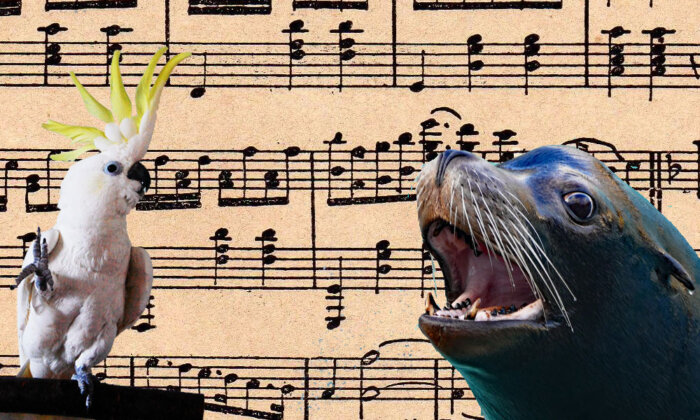Are Humans the Only Musical Species?

We are all born with a predisposition for music, one that develops spontaneously and is refined by listening to music. Think, for example, of relative pitch, recognizing a melody separately from the exact pitch or tempo at which it is sung, and beat perception, hearing regularity in a varying rhythm. Even human newborns turn out to be sensitive to intonation or melody, rhythm, and the dynamics of the noise in their surroundings. Everything suggests that human biology is primed for music at birth with respect to both the perception and enjoyment of listening.
As such, the human capacity for music appears to be special. But what makes it special, and is our musical predisposition unique, like our linguistic ability? Or is musicality something with a long evolutionary history that we share with other animals?

Charles Darwin assumed that all animals can detect and appreciate melody and rhythm simply because they have a nervous system comparable to that of humans. He therefore had no doubt that human musicality had a biological foundation and a long evolutionary history, an idea that inspired a new field of scientific study — biomusicology — and set me on the path to writing my book, “The Evolving Animal Orchestra.”
My journey began in 2009 when, together with a group of Hungarian researchers, I discovered that human infants have beat perception, a prerequisite for being able to dance or make music together. Both the brains and the hearing capacity of human infants turned out to be primed for music. This conclusion raised the question of whether musicality was exclusively human or perhaps a trait possessed by all animals, as Darwin suspected.
Even human newborns turn out to be sensitive to intonation or melody, rhythm, and the dynamics of the noise in their surroundings.
To answer this question, I asked numerous behavioral biologists and neurobiologists whether it was possible to perform the same listening experiment with rhesus macaques as we had done with human newborns. In this way, I hoped to be able to discover whether rhesus macaques, whose ancestors had split off from other nonhuman primates at about the same time as our human ancestors — some 23 million years ago — also respond to the beat of music.
Most of the primatologists I spoke with were skeptical about the idea of using a measurement method on monkeys that had once been used on human infants, namely, an EEG (involving electrodes attached to the skull). But the neurobiologist Hugo Merchant leapt at the idea. Within a few weeks, his research group at the Universidad Nacional Autónoma de México had assembled all the necessary software and hardware to make the first trial measurements. Unfortunately, after more than a year of setbacks and new insights, we had had to conclude that rhesus macaques do not have beat perception. This finding ran totally contrary to what I had expected and to Darwin’s assumption.
Until then, scientists had widely believed that the heartbeat was the source of beat perception. After all, all mammals, including rhesus macaques and humans, hear their mother’s heartbeat in the womb. Our research findings made that hypothesis much less likely. Apparently, specific neural networks are necessary to enable beat perception. In rhesus macaques, these networks are weaker or perhaps even nonexistent. The brain, therefore, rather than the physiology, is the decisive factor here.
Primatologist Yuko Hattori’s initial findings suggested that chimpanzees have beat perception, thus allowing us to date the origins of human beat perception to the common ancestor of humans and chimpanzees, some five to ten million years ago.
Our study and others led to the development of the gradual audiomotor evolution (GAE) hypothesis, which posits that neural networks allow for beat perception in humans, a result of strong bidirectional connections between the auditory cortex and the motor cortex (these connections are present only with limited properties in other nonhuman primates). Chimpanzees, GAE predicts, also have a rudimentary form of beat perception, owing to a more gradual development of the same connections that developed as nonhuman primates evolved.
This theory led me to visit the Primate Research Institute in Inuyama, Japan, where the primatologist Yuko Hattori was investigating the musicality of chimpanzees. Her initial findings suggested that chimpanzees do indeed have beat perception, thus allowing us to date the origins of human beat perception to the common ancestor of humans and chimpanzees, some five to ten million years ago. Last month, the study was published in the Proceedings of The National Academy of Sciences and confirmed the GAE hypothesis.
All this research happened several years after the discovery of Snowball, a sulphur-crested cockatoo who could dance to the beat of music. Snowball was responsible for a renewed global interest in the biological foundations of musicality and the discovery represented a first major step forward in support of Darwin’s hypothesis. It also generated new questions, among them: Why did humans and cockatoos but not rhesus macaques develop beat perception?
Ani Patel, a neuroscientist at Tufts University, offered one theory: The ability to hear regularity in music, he proposed, may be based on vocal learning — that is, the ability to learn and imitate new sounds. The “vocal learning as precondition for beat perception” (VL) hypothesis predicts that, rather than sharing beat perception with other mammals, such as horses, dogs, and rhesus macaques, humans may share it with specific bird species, such as cockatoos (including the now-famous Snowball), budgerigars (common parakeets), and zebra finches.
However, in 2013, an extensive study from the laboratory of the behavioral biologist Colleen Reichmuth of the University of California, Santa Cruz, unexpectedly appeared and fueled the debate about the VL hypothesis. The publication compellingly demonstrated that Ronan, a California sea lion, had beat perception, whereas this species is believed not to be a vocal learner. Although it is difficult to prove the absence of a trait — in this case perhaps the undiscovered vocal learning ability of sea lions — there were many indications that sea lions do not have this ability. Yet Ronan appeared to be able to move convincingly to the beat of the music. Ronan, it turned out, was an exception, a counter-example falsifying the VL hypothesis.
While not all animals appear to have musical skills like beat perception or relative pitch, it has become increasingly likely that musicality has a biological basis and a long evolutionary history. After a decade of exciting new findings, then, it seems that Darwin was at least partly right.
Henkjan Honing (@musiccognition) is a professor of Music Cognition at the University of Amsterdam, the Netherlands. He is the author of “The Evolving Animal Orchestra: In Search of What Makes Us Musical” and editor of “The Origins of Musicality,” both published at The MIT Press.



